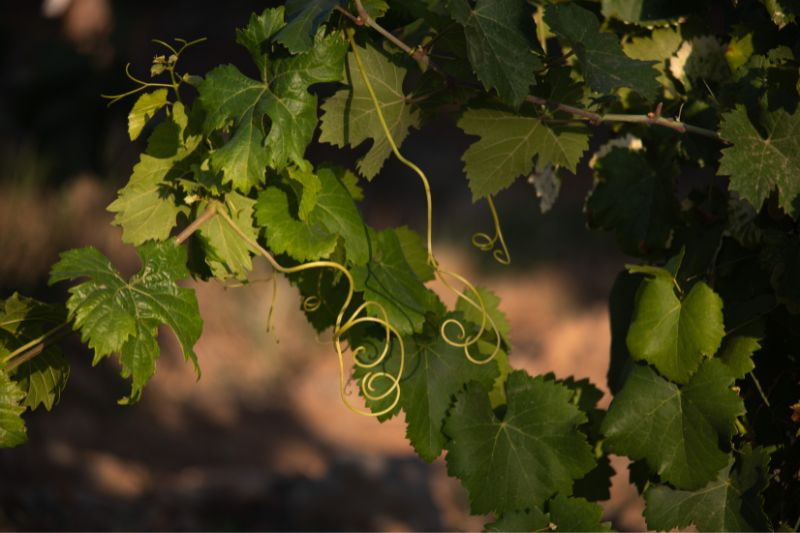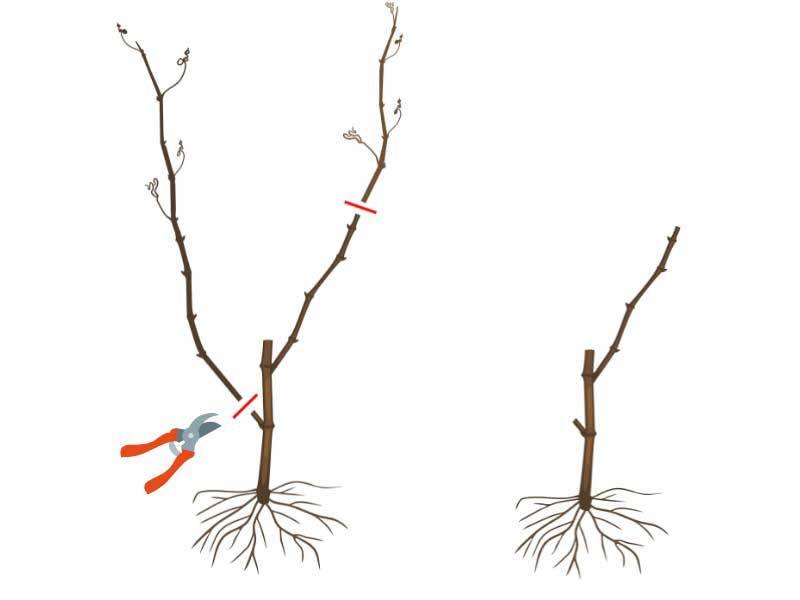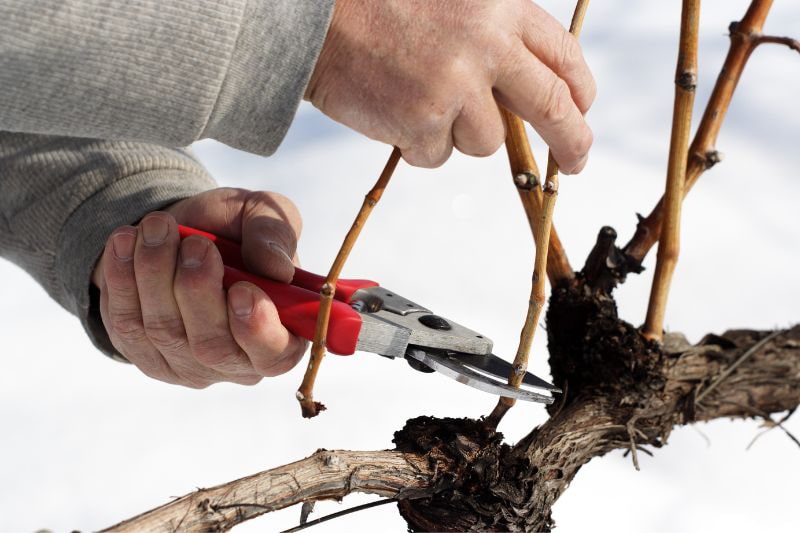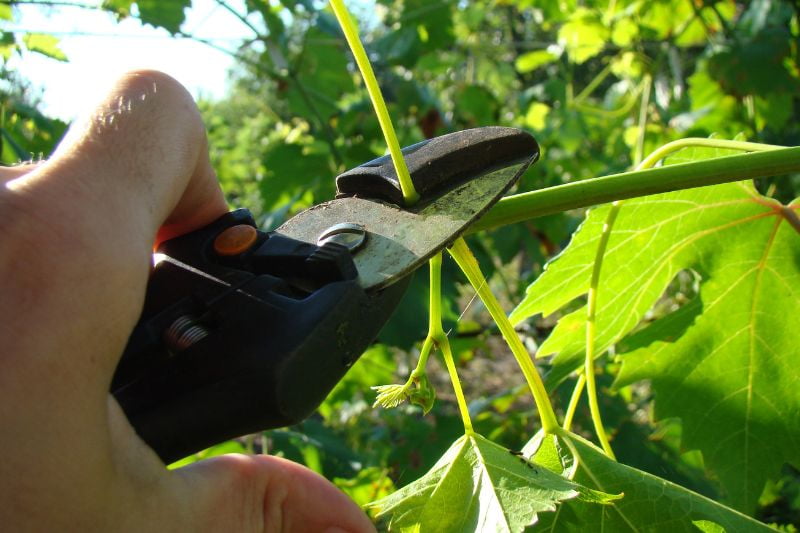The grapevine (Vitis vinifera), a vigorous shrub with voluble branches, quickly becomes invasive without maintenance. That is why pruning the grapevine is essential: it makes harvest easier and boosts grape production. Whether you want to know the ideal time to prune grapevine, or how to prune grapevine to a goblet shape, we guide you step by step to perform the right actions. If you have a few vine-plants at home, it is probably for personal consumption rather than producing a great vintage… Pruning a table-grape grapevine will therefore be fairly simple, much less technical than vinegrowers' work. Discover when and how to prune grapevine correctly for a generous, controlled harvest!
Why pruning grapevine?
Being a voluble liana equipped with tendrils, grapevine grows very quickly. Its stems coil around any support and the tendrils secure the branches. These branches can reach 6 to 7 metres in length, or more for some varieties. Grapes from an unpruned vine are likely to be smaller. That is why pruning grapevine is essential to:
- Stimulate grape production: without pruning, grapevine produces lots of wood and leaves, but few fruits.
- Direct growth: pruning grapevine shapes it and gives it an appropriate habit (espalier, goblet, cordon…).
- Improve light and ventilation: by limiting foliage, helping clusters to ripen properly and reducing disease risk.
- Renew fruit-bearing wood: clusters mainly form on the previous year's woody climbing stems. Pruning helps make room for new ones.

When to prune grapevine?
The pruning period for grapevine varies with the season. So, when to cut grapevine? Here are the two key moments:
- Winter pruning of grapevine, which structures the plant and prepares production.
- Summer pruning, called green pruning, to manage vigour and favour the clusters.
Training prune
- Period: during planting year, at end of winter (February–March depending on region)
- Objective: give shape to grapevine (goblet, cordon, Guyot, etc.). Select main branches (framework branches) to build the plant’s skeleton.

Clear explanatory diagram to master fruiting pruning

Fruiting pruning
- Period: in winter, outside freezing periods, between November and March (ideally February)
- Objective: stimulate grape production for following year. Remove old wood and keep only the current year's woody climbing stems that will bear fruit.
Green pruning
- Period: from May to July (depending on vigour)
- Objective: manage vegetation during growing season. Remove unnecessary shoots, remove suckers, thin leaves to aerate clusters and limit disease.

How to prune grapevine?
In this tutorial, we focus only on table-grape grapevine, as this is what most amateur gardeners grow. The main goal here is to obtain beautiful, sweet clusters, with fleshy berries, easy to harvest and enjoyable to share with family or friends.
Necessary equipment
- A quality pruning shear (perfect for a few grapevines in a garden)
- A geared pruning shear or an electric pruning shear (useful if you have several vines to prune, to reduce effort)
- 90°C alcohol to clean and disinfect tools before and after use
- A good pair of gloves to protect hands and avoid blisters
No need for complex diagrams or professional vinegrower techniques to prune a garden grapevine correctly:
1. Identify previous year's woody climbing stems
These are the thin stems that grew last year. They are the ones that will bear grapes this year.
2. Choose a few well-placed woody climbing stems
Keep 2 to 4 woody climbing stems well oriented (not too tangled, not pointing inwards) and vigorous. No need to keep more: too many will produce excessive foliage and fewer fruits.
3. Prune these woody climbing stems to 8–10 eyes (buds)
Future clusters will grow from these eyes. Cut just above the last eye you wish to keep.
4. Remove unnecessary wood
All dead, weak, badly oriented or too-old wood can be removed. This helps aerate the grapevine and concentrate energy on fruiting woody climbing stems.
5. Renew woody climbing stems each year
At each end of winter, sort: remove old woody climbing stems that have fruited, keep young ones that will produce. It is a cycle!
Different types of pruning
Depending on the shape given to the vine, pruning method will vary slightly.
Pruning an espalier grapevine
Grapevine is trained along wires or a trellis.
- Keep 1 to 2 long well-developed woody climbing stems, which are tied horizontally to the support (trellis, wires, etc.).
- Each woody climbing stem is pruned to 8–10 eyes to maximise production.
Pruning a goblet-shaped grapevine
Traditional shape, without training, with short arms arranged like a star.
- Keep 3 to 5 short main arms (called framework branches) arranged around the trunk.
- Each arm bears 1 or 2 spurs (that is, short woody climbing stems pruned to
2 or 3 eyes) that will give this year's fruit.
Pruning a cordon grapevine
Grapevine is formed with one or two fixed horizontal arms (the cordon), from which spurs grow each year.
- Prune each spur short, to 2 eyes, to renew production.
Common mistakes to avoid when pruning grapevine
- Pruning too early in winter: pruning before the worst frosts have passed risks exposing vine to freeze damage. Wait until late winter when severe frosts are over.
- Not disinfecting tools: this promotes disease transmission from one vine to another. Always clean your pruning shear with 90° alcohol before and after use.
- Leaving too much wood: if you keep too many woody climbing stems or too many buds, vine will produce lots of foliage at expense of grapes.
- Pruning too short on young vines: young vines need to develop. Over-severe pruning can slow their growth.
- Cutting too close to the bud: this can damage it. Always leave a small centimetre above the last eye kept.
- Forgetting green pruning in summer: it is essential to reduce congestion, improve light and limit disease.
































Comments